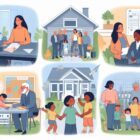Public Housing Agencies: Their Impact on Subsidized Living

If you’ve ever wondered about the true impact of public housing agencies on subsidized living, look no further. In this article, we delve into the history, programs, and initiatives that have shaped these agencies, and examine the tangible effects they have on low-income individuals and families.
From community development to revitalization efforts, public housing agencies play a vital role in shaping our society. Join us as we explore the challenges they face and the promising future ahead.
Key Takeaways
- Public housing agencies have a long history of addressing housing shortages and improving living conditions, with the Housing Act of 1937 providing federal funding for public housing projects.
- Affordable housing programs and initiatives, such as rental assistance programs and low-income housing tax credits, play a crucial role in providing affordable housing options and addressing the ongoing need for affordable housing in communities.
- Public housing agencies significantly improve the quality of life for low-income individuals and families by alleviating financial burdens, improving health and education outcomes, and providing support services to address underlying factors contributing to poverty.
- Community development and revitalization efforts, including affordable housing options, economic development, infrastructure improvement, and provision of social services, contribute to thriving neighborhoods and residents’ well-being.
History and Evolution of Public Housing Agencies
To understand the current state of public housing agencies, it’s important to examine their history and how they’ve evolved over time. Public housing agencies (PHAs) have undergone significant changes since their establishment in the early 20th century. Initially, PHAs were created to address the pressing issue of housing shortages and improve living conditions for low-income individuals and families.
The Housing Act of 1937 marked a turning point, as it provided federal funding for the development of public housing projects. This led to the construction of thousands of units across the country, providing affordable housing options for those in need.
Over the years, PHAs have faced various challenges and criticisms. One major concern was the concentration of poverty in public housing developments, leading to social and economic disparities. As a response, the HOPE VI program was introduced in the 1990s, aiming to revitalize distressed public housing and promote mixed-income communities. This initiative emphasized the importance of integrating public housing residents into the larger community and fostering self-sufficiency.
Today, PHAs continue to play a crucial role in providing affordable housing options for vulnerable populations. However, the landscape has evolved to include a broader range of housing assistance programs, such as the Housing Choice Voucher Program (Section 8). This program allows eligible individuals and families to choose their housing in the private market, offering more flexibility and choice.
Affordable Housing Programs and Initiatives
As we delve into the topic of affordable housing programs and initiatives, let’s explore how public housing agencies have implemented various measures to address the ongoing need for subsidized living.
- Rental Assistance Programs: Public housing agencies provide rental assistance to low-income individuals and families through programs such as the Housing Choice Voucher Program (Section 8). These programs help subsidize the cost of renting in the private market, making housing more affordable for those in need.
- Low-Income Housing Tax Credits: Public housing agencies work with developers and investors to allocate low-income housing tax credits. These credits incentivize the construction or rehabilitation of affordable housing units, increasing the supply of affordable housing in communities.
- Public-Private Partnerships: Many public housing agencies collaborate with private developers to create mixed-income developments. By combining market-rate and affordable housing units, these partnerships promote economic integration and provide affordable housing opportunities in desirable neighborhoods.
- Supportive Housing Programs: Public housing agencies also play a critical role in providing supportive housing for individuals with special needs, such as the elderly, disabled, or those experiencing homelessness. These programs offer not only affordable housing but also access to essential support services, enhancing the overall well-being of residents.
Through these various initiatives and programs, public housing agencies strive to address the ongoing need for affordable housing in communities across the country. By leveraging partnerships, subsidies, tax credits, and support services, these agencies aim to create sustainable and inclusive communities for individuals and families in need.
Impact on Low-Income Individuals and Families
Public housing agencies significantly improve the quality of life for low-income individuals and families by providing essential support and affordable housing options. These agencies play a crucial role in addressing the housing needs of vulnerable populations, ensuring that they have a safe and stable place to live. According to data from the U.S. Department of Housing and Urban Development (HUD), there are approximately 4.7 million low-income households receiving assistance through public housing programs.
By offering affordable housing options, public housing agencies help to alleviate the financial burden on low-income individuals and families. This allows them to allocate their limited resources towards other basic needs, such as food, healthcare, and education. Research has shown that stable housing is closely linked to improved health outcomes, educational attainment, and employment opportunities. Therefore, by providing affordable housing, public housing agencies contribute to breaking the cycle of poverty and promoting upward mobility.
Furthermore, public housing agencies also offer essential support services to low-income individuals and families. These services may include job training, educational programs, childcare assistance, and counseling. By addressing the underlying factors that contribute to poverty, these agencies help individuals and families build a foundation for long-term success.
Community Development and Revitalization Efforts
Community development and revitalization efforts are essential for creating thriving neighborhoods and improving the overall well-being of residents. These initiatives play a crucial role in transforming distressed areas into vibrant communities, providing residents with access to quality housing, education, healthcare, and employment opportunities.
Here are four key aspects that highlight the importance of community development and revitalization efforts:
- Affordable Housing: One of the primary objectives of these efforts is to provide affordable housing options for low-income individuals and families. This ensures that residents have a stable and secure place to live, reducing the risk of homelessness and housing instability.
- Economic Development: Community development initiatives focus on stimulating economic growth by attracting businesses and creating job opportunities. This not only improves the financial stability of residents but also contributes to the overall economic prosperity of the neighborhood.
- Infrastructure Improvement: Revitalization efforts often involve upgrading infrastructure, such as roads, parks, and community facilities. These improvements enhance the quality of life for residents, making the neighborhood more attractive and conducive to community engagement and social interaction.
- Social Services: Community development initiatives also prioritize the provision of social services, including healthcare, education, and youth programs. These services address the needs of residents and promote social well-being, fostering a sense of community and belonging.
As community development and revitalization efforts continue to shape public housing agencies’ strategies, it’s important to acknowledge the challenges and consider the future outlook for PHAs.
Challenges and Future Outlook for PHAs
Facing numerous obstacles, you must navigate the challenges and consider the future outlook for PHAs in their quest to provide subsidized living.
Public Housing Agencies (PHAs) face several challenges that impact their ability to fulfill their mission effectively. One significant challenge is the limited funding available for affordable housing programs. In recent years, federal funding for PHAs hasn’t kept pace with the growing demand for subsidized housing, resulting in substantial waiting lists and an inability to provide housing to all eligible individuals and families.
Another challenge is the aging infrastructure of existing public housing units. Many PHAs struggle to maintain and repair their properties due to budget constraints. As a result, residents often face substandard living conditions, including plumbing issues, mold, and outdated amenities.
Moreover, PHAs must address the need for broader housing options. While traditional public housing has been the primary focus, there’s an increasing recognition of the importance of alternative approaches, such as vouchers and Section 8 housing. These programs offer more flexibility and empower individuals and families to choose their own housing, promoting self-sufficiency and community integration.
Looking ahead, the future outlook for PHAs is influenced by various factors. One key factor is the political landscape and the commitment of policymakers to prioritize affordable housing. Additionally, advancements in technology and data analytics can enhance PHAs’ ability to target resources efficiently and improve the overall management of subsidized housing programs.
To overcome the challenges and ensure a bright future, PHAs must advocate for increased funding, prioritize property maintenance and modernization, and embrace innovative approaches to affordable housing. By addressing these obstacles and adapting to changing needs, PHAs can continue to make a positive impact on subsidized living.
Frequently Asked Questions
How Do Public Housing Agencies Determine Eligibility for Subsidized Housing Programs?
To determine eligibility for subsidized housing programs, public housing agencies evaluate factors such as income, family size, and citizenship status. They use this information to assess the level of need and ensure fair distribution of housing assistance.
Are There Any Income Limits or Restrictions for Individuals and Families Seeking Public Housing Assistance?
There are income limits and restrictions for individuals and families seeking public housing assistance. These limits ensure that the limited resources are allocated to those who have the greatest need for subsidized housing.
What Types of Housing Options Are Available Through Public Housing Agencies?
Public housing agencies offer various housing options, including apartments, townhouses, and single-family homes. These options are designed to provide affordable and safe housing for individuals and families in need.
Are There Any Additional Services or Resources Provided by PHAs to Support Low-Income Individuals and Families?
There are additional services and resources provided by PHAs to support low-income individuals and families. These include access to job training programs, educational resources, childcare assistance, and healthcare services.
What Are the Key Differences Between Public Housing Agencies and Other Affordable Housing Programs, Such as Section 8?
The key differences between public housing agencies and other affordable housing programs, such as Section 8, can be explained by examining their funding sources, eligibility requirements, and the types of housing they offer.



